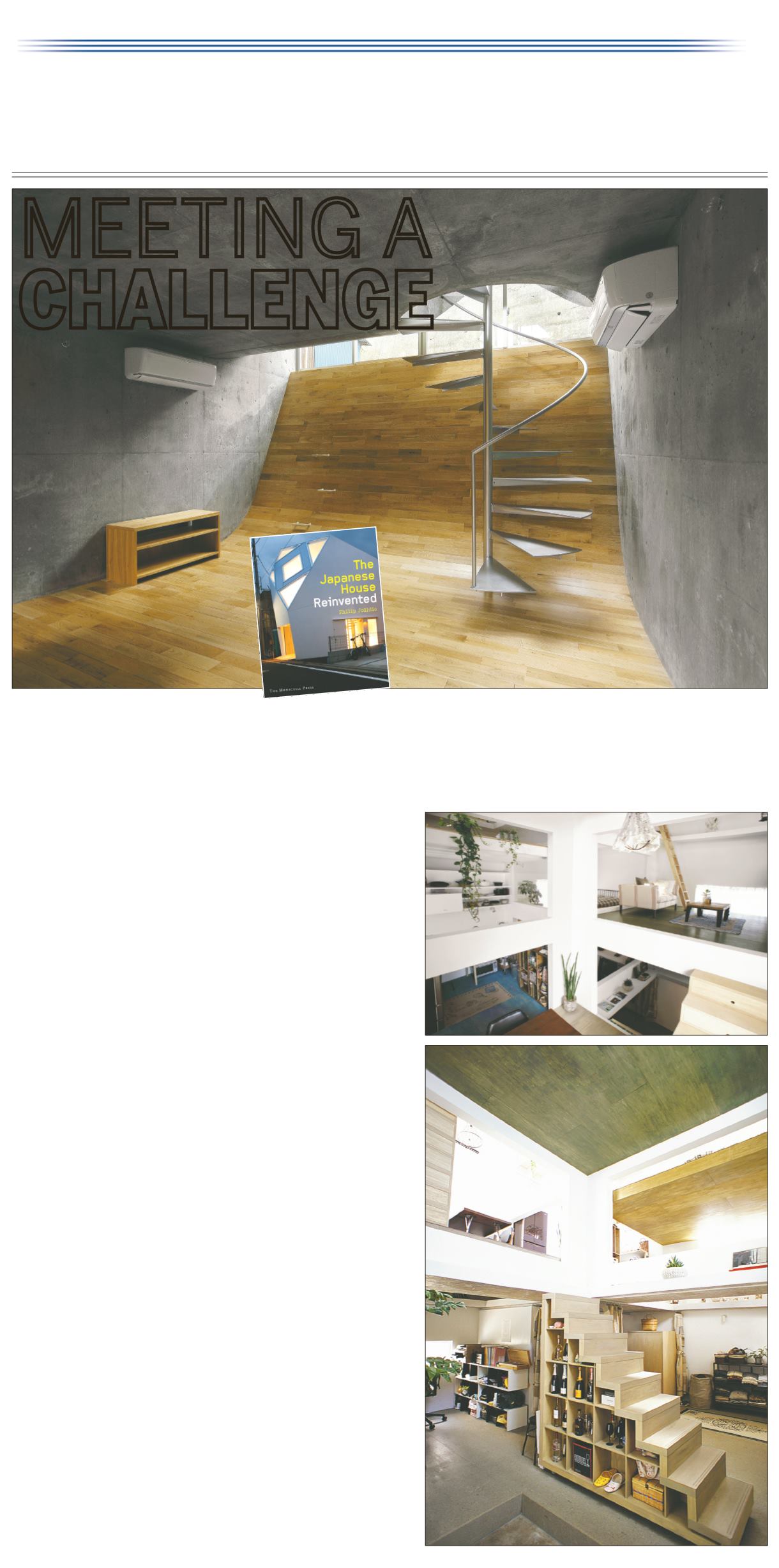
C
TROPICAL GARDENER
| IN THIS SECTION
HOME
SUNDAY, JUNE 21, 2015 | WEST HAWAII TODAY
BOOK EXPLORES INNOVATIONS OF
MODERN JAPANESE HOME DESIGN
MEETING A
CHALLENGE
C
hallenged to build homes that
create a feeling of light, space
and tranquility in some of the
world’s most densely populated areas,
Japanese architects have had no choice
but to think outside the box. Literally.
Basic elements like walls, windows
and floors are reinvented to solve
design conundrums, such as homes
built on footprints the size of studio
apartments or surrounded on all sides
by other buildings. Frequently, the
materials of choice are a combination of
reinforced concrete, wood and glass.
With interest in micro-housing
growing worldwide, such innovations
have made Japanese architecture a
leading force in contemporary home
design. A new book, “The Japanese
House Reinvented” (Monacelli Press)
by Philip Jodidio, surveys more than
50 contemporary homes, by both
emerging and established firms.
“Faced with the constraints of very dense
urban areas and a lifestyle that has long
taken into account small spaces, Japanese
architects and their clients have shown
a surprising willingness to experiment,”
writes Jodidio, who has written more
than 100 books on contemporary
architecture, including monographs on
architects Tadao Ando and Shigeru Ban.
The elegant houses in the book
seem almost miraculously livable
and show a way forward for
challenging architectural puzzles.
But they are not for the timid.
In a Yokohama house designed by
Takeshi Hosaka Architects, the basement
level of a 980-square-foot house features
a hardwood floor that slopes sharply
upward at one end toward the street-level
window above, resembling a sleek sort
of skateboard ramp. There is no defining
line between floor and wall. The ceiling, in
turn, slopes steeply upward, allowing for
an enormous, almost story-high window.
The unusual design creates an urban
basement with plenty of natural light and
privacy all at the same time, and gives the
diminutive two-story building the outward
appearance of being three stories tall.
An even tinier home in Tokyo, this one
designed by Koji Tsutsui and Associates,
features powerfully angled “bent boxes”
of reinforced concrete, which manage to
hide views of neighboring houses while
allowing in sunlight through a partially
sheltered balcony. There’s space on the
balcony for a few plants and small trees.
“For a house this small, surrounded on
all four sides, we had be really creative
about light, and the space had to be very
multi-purpose,” said Satoshi Ohkami,
an associate at the firm, adding that
many Japanese design solutions could
be applied elsewhere in the world.
In a similarly small Tokyo house by
Hiroyuki Shinozaki Architects, a movable
staircase separated from the structure
allows for different shelf-like floor levels at
irregular heights, and rooms that can be
easily reconfigured for changing needs.
Not all the houses are
diminutive, however.
Like many Americans, Japanese tend
to prefer houses over apartments, and
roughly 60 percent of Japanese dwellings
are single-family homes, Jodidio writes.
Many of them are in dense urban areas.
See-through flooring, reflective ceilings,
plentiful balconies, mezzanines and
inner courtyards, and windows and
walls at surprising angles are more the
rule than the exception among homes
by these Japanese architects. Windows
come in all shapes and sizes, frequently
appearing at unexpected angles. And light-
drenched inner courtyards are juxtaposed
by frequently closed-looking exteriors,
some of which even conceal entries.
The architect Go Hasegawa designed
one Tokyo house with a louvered floor,
consisting of wood flooring with generous
slivers of open space between the
floorboards, giving the illusion of space
and allowing sunlight from a big upper
window to reach the ground floor.
“It is truly open. Air, sound, smell
and the everyday life of the family
come up and down through this
louvered floor,” Hasegawa said.
“Now is the moment we can innovate the
house and help create a new way of living.
Not only architects, but I feel clients,
also,” are engaged in that quest, he said.
Much as sliding, rice-paper
screens traditionally made indoor
areas more flexible in Japan,
intermediate floor levels and inner
open spaces add a feeling of space.
And the grandeur of nature is evident
in simple yet dramatic touches, such
as a single tree in a minuscule inner
courtyard or balcony, or a sliver of
visible sky at the top of a wall.
“We design minimalist and clean
design to get rid of clutter,” said Ohkami,
speaking from Mill Valley, California,
where his firm has a studio (Tsutsui
is currently a visiting professor at the
University of California in Berkeley). “We
focus on details and materials within
the space to create the character, and
the materials become very important.
Concrete is a lot more common in Japan
in the United States. People are hesitant
here to use concrete. I don’t know why
exactly. Architecture has to be flexible.”
BY KATHERINE ROTH
THE ASSOCIATED PRESS
The cover of the book, “The Japanese
House Reinvented,” by Philip Jodidio.
PHOTOS BY THE MONACELLI PRESS/THE ASSOCIATED PRESS
Above: “House T,” designed by Hiroyuki Shinozaki Architects/Tokyo.
“House in
Byoubugaura,”
designed by
Takeshi Hosaka
Architects/
Yokohama.
NACASA & PARTNERS INC


